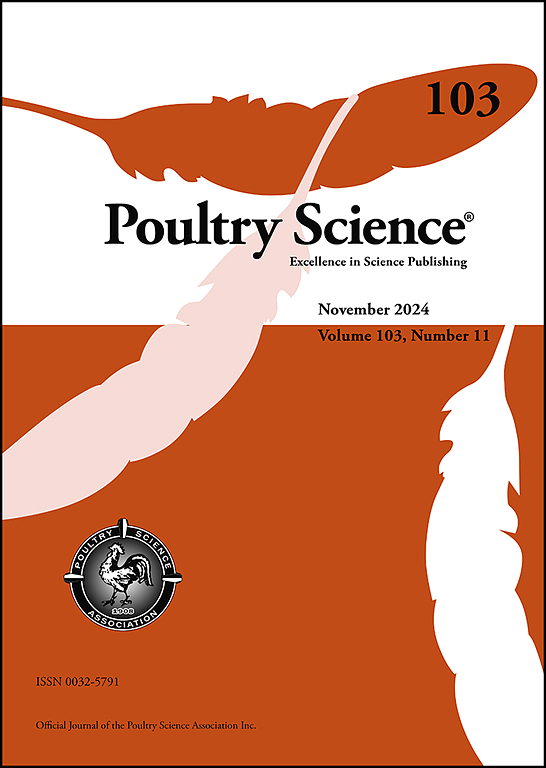白菇茎粉在蛋鸡饲粮中可持续替代豆粕的研究
IF 4.2
1区 农林科学
Q1 AGRICULTURE, DAIRY & ANIMAL SCIENCE
引用次数: 0
摘要
在家禽日粮中寻找可持续和具有成本效益的豆粕蛋白替代品日益成为一个优先事项。白蘑菇茎(WMS)是一种营养丰富的蘑菇栽培副产品,由于其蛋白质、纤维和生物活性化合物的含量,可能提供一种可行的解决方案。本试验旨在评价饲粮中添加WMS粉对蛋鸡生长、器官发育、血液生化和气体排放的影响。试验选用160只3周龄Lohmann LSL Lite雏鸡,随机分为添加0%(对照)、2%、4%和6% WMS粉的4个饲粮处理,每5个重复,每个重复8只鸡。每周记录体重,同时使用基于传感器的检测系统测量气体排放量(CO₂,CH₄和NH₃)。在为期5周的试验结束时,采集血液和内脏进行进一步分析。当WMS含量达到6%时,没有显著影响(线性和二次P >;0.10)对体重、增重、采食量、饲料系数或相对器官重量的影响。血清生化指标,包括肝肾功能指标,不受添加WMS的影响(线性和二次P >;0.10)。然而,WMS影响血清矿物质谱,对钙观察到显著的线性或二次效应(线性P = 0.019;二次P = 0.047)、磷(二次P = 0.005)、钠(线性P = 0.033;二次P = 0.023)、钾(线性P = 0.017)和氯化物(线性P = 0.015;二次P = 0.026)浓度。气体排放表现出剂量依赖性,CO₂呈线性减少(P <;0.001), nh3和nh4均呈线性(P <;0.001)和二次(P <;0.046)趋势。综上所述,添加6%的WMS对鸟类生产性能没有负面影响,并可能有助于减少气体排放,强调了其作为家禽日粮中豆粕的可持续替代品的潜力。本文章由计算机程序翻译,如有差异,请以英文原文为准。
Utilizing white mushroom stem powder as a sustainable substitute for soybean meal in layer chick diets
The search for sustainable and cost-effective protein alternatives to soybean meals in poultry diets is a growing priority. White mushroom stems (WMS), a nutrient-dense byproduct of mushroom cultivation, may offer a viable solution due to their content of protein, fiber, and bioactive compounds. This study evaluated the effects of dietary WMS powder on growth, organ development, blood biochemistry, and gas emissions in layer pullets. A total of 160 three-week-old Lohmann LSL Lite pullets were randomly allocated to four dietary treatments containing 0% (control), 2%, 4%, or 6% WMS powder with five replicates of eight birds each. Body weight was recorded weekly, while gas emissions (CO₂, CH₄, and NH₃) were measured using a sensor-based detection system. At the end of a 5-week-long trial, blood and internal organs were collected for further analysis. The inclusion of WMS at levels up to 6% had no significant effect (linear and quadratic P > 0.10) on body weight, weight gain, feed intake, feed conversion ratio, or relative organ weights. Serum biochemical markers, including liver and kidney function indicators, were unaffected by WMS supplementation (linear and quadratic P > 0.10). However, WMS influenced serum mineral profiles, with significant linear or quadratic effects observed for calcium (linear P = 0.019; quadratic P = 0.047), phosphorus (quadratic P = 0.005), sodium (linear P = 0.033; quadratic P = 0.023), potassium (linear P = 0.017), and chloride (linear P = 0.015; quadratic P = 0.026) concentrations. Gas emissions exhibited dose-dependent responses, with CO₂ decreasing linearly (P < 0.001), and NH₃ and CH₄ showing both linear (P < 0.001) and quadratic (P < 0.046) trends. In conclusion, adding WMS up to 6% had no negative impact on bird performance and may help reduce gas emissions, emphasizing its potential as a sustainable alternative to soybean meal in poultry diets.
求助全文
通过发布文献求助,成功后即可免费获取论文全文。
去求助
来源期刊

Poultry Science
农林科学-奶制品与动物科学
CiteScore
7.60
自引率
15.90%
发文量
0
审稿时长
94 days
期刊介绍:
First self-published in 1921, Poultry Science is an internationally renowned monthly journal, known as the authoritative source for a broad range of poultry information and high-caliber research. The journal plays a pivotal role in the dissemination of preeminent poultry-related knowledge across all disciplines. As of January 2020, Poultry Science will become an Open Access journal with no subscription charges, meaning authors who publish here can make their research immediately, permanently, and freely accessible worldwide while retaining copyright to their work. Papers submitted for publication after October 1, 2019 will be published as Open Access papers.
An international journal, Poultry Science publishes original papers, research notes, symposium papers, and reviews of basic science as applied to poultry. This authoritative source of poultry information is consistently ranked by ISI Impact Factor as one of the top 10 agriculture, dairy and animal science journals to deliver high-caliber research. Currently it is the highest-ranked (by Impact Factor and Eigenfactor) journal dedicated to publishing poultry research. Subject areas include breeding, genetics, education, production, management, environment, health, behavior, welfare, immunology, molecular biology, metabolism, nutrition, physiology, reproduction, processing, and products.
 求助内容:
求助内容: 应助结果提醒方式:
应助结果提醒方式:


